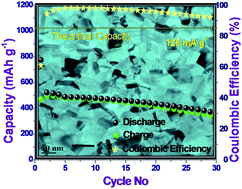Excellent electrochemical performance of tin monosulphide (SnS) as a sodium-ion battery anode†
Abstract
Tin monosulphide is synthesized by a simple wet chemical synthesis approach. The as-prepared tin monosulphide has been used as anode in Na-ion battery without any in situ conductive carbon or graphene coating, and the electrode exhibits a high reversible sodium reversible capacity of ∼500 mA h g−1 at a discharge rate of 125 mA g−1. It also demonstrates excellent high rate performance (i.e. 390 and 300 mA h g−1 at 500 and 1000 mA g−1 current density respectively) and cycle stability without the addition of any expensive additive stabilizer, such as fluoroethylene carbonate (FEC), in comparison to those in current literature.


 Please wait while we load your content...
Please wait while we load your content...